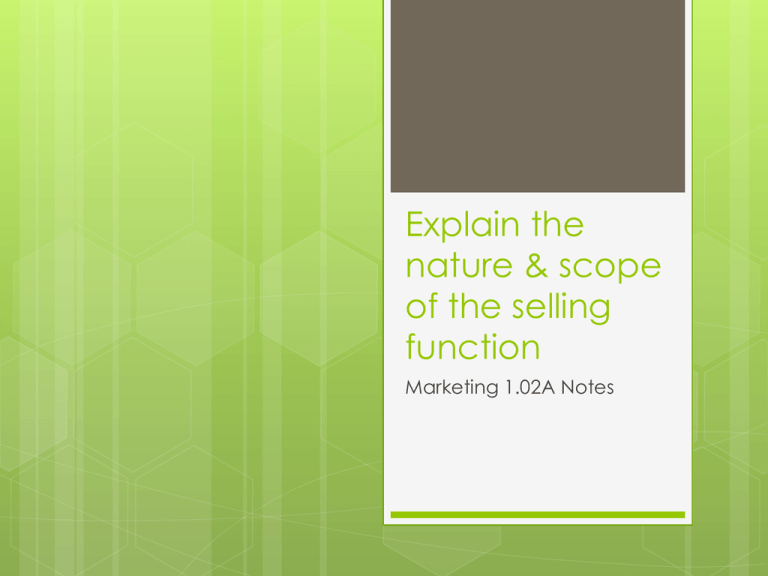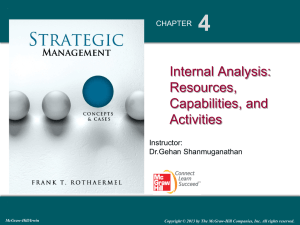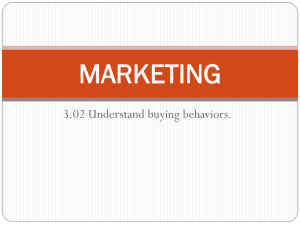Explain the nature & scope of the selling function
advertisement

Explain the nature & scope of the selling function Marketing 1.02A Notes What is Selling? Selling is responding to consumer needs and wants through planned, personalized communication in order to influence purchase decisions and ensure satisfaction. Planned communication Personalized communication Influences purchase decisions Should ensure customer satisfaction Individuals that sell A farmer sells produce at a roadside stand An artisan sells handmade baskets at a craft show A doctor treats a patient A retailer sells a DVD player A hairstylist gives a haircut An accountant prepares a customer’s tax forms Groups that sell Department stores buy shoes to resell to customers Wholesaler buys candy to resell at a grocery store College bookstore buys books to resell to students Organizations/Agencies that sell for use in operations Some are used to produce other goods Pizza restaurant buying pepperoni for its pizza Furniture manufacturer buys fabric to use on its chairs/sofas Some are used for general operating purposes Pizza restaurant purchases ovens to bake its pizzas in Furniture manufacturer purchases trucks for delivering its products to wholesalers and retailers Types of Items Sold Tangible products are those items that can be touched, smelled, tasted, seen or heard. Clothes Houses Food DVDs Types of Items Sold Intangible products are productive activities that we pay someone else to perform They are services provided to customers Dry cleaning Lawn care Health care Tangible & Intangible Items Tangible products have intangible aspects to them Intangible products have tangible aspects attached to them as well A diamond engagement ring is tangible, but it signifies many intangible feelings and emotions, such as love and commitment. Where Selling Occurs Selling happens anywhere person-toperson contact is made. Over the phone On the doorstep of a person’s home At a customer’s place of business In a store or office How Products Are Sold Some goods and services are sold directly to the consumer or user without the use of a wholesaler or retailer. Selling magazines door-todoor Selling candy to friends and relatives to raise money for a student organization Selling products such as cosmetics and Tupperware through home shows How Products Are Sold Goods and services sold indirectly to the consumer by intermediaries (wholesalers & retailers) Video stores purchase from suppliers and then sell or rent DVDs to customers An athlete’s agent gets him/her a five-yr contract with a professional sports team Role of Selling in a Market Economy Selling keeps our economy moving Businesses buy resources (natural, human, capital) to be used in the production of goods and services and sell to the market that wants them Manufacturers Wholesalers Retailers Individuals and households Role of Selling in a Market Economy Individuals sell their resources to businesses to help in the production of goods and services No economic flow Keeps our economy moving Role of Selling in a Market Economy Selling promotes competition All businesses compete for scarce customer dollars Sell the most products + satisfy customer needs + best prices = success Develop new or improved products to make more sales than their competitors Roles of Selling in a Market Economy Selling affects employment Jobs depend on making sales Businesses grow, more salespeople are hired to keep up with the demand of products Example: Starbucks Roles of Selling in a Market Economy Selling adds utility. Products can be “in the right place at the right time” Creating customer desire Suggest accessories to go with an outfit Selling helps customers determine needs Enables customers to receive help with their buying problems Customers can determine their needs and select products that are right for them Roles of Selling in a Market Economy Selling creates desire for products Create desire for new or established products Determine customers’ needs, wants, and buying motives Explaining product features and benefits to customers Heightening their desire through the use of demonstrations Characteristics of a Successful Salespeople Education and Training Self-Motivation Self-Confidence Product Knowledge Customer Knowledge Ethics Persistence and Patience Selling Skills Characteristics of Successful Salespeople Belief in selling as a service Communication Skills Creativity Personal Appearance WHY DO CONSUMERS BUY? To obtain the goods and services they desire or must have to exist (ultimate consumption) For resale For use in business operations Used in the production of other goods Used to operate the business BUYING MOTIVES Emotional – based on emotion (ex. Social approval, recognition, power, love, prestige) Rational – conscious, logical reasons for purchase (ex. Saves time or money, quality, service) Motive? Explain the role of customer service as a component of selling relationships. CUSTOMER SERVICE PROCESS V. FUNCTION Process– customer satisfaction always comes first Function–responds to complaints from customers CUSTOMER SERVICE HELP YOU BEAT COMPETITION? Quality of products can be easily matched among competitors. Therefore customer service becomes key! FACTORS of customer service expectations: Past Experiences same or higher quality than before Word-of-Mouth same quality service others have received Advertising you to make good on advertising claims of quality service Personal Needs “reading” customers and cater to their personal needs CUSTOMER SERVICE = RELATIONSHIPS Maintain Relationships Happy customers return and refer friends It’s more expensive to replace customers than it is to maintain them Create Loyalty through Rewards PRE-SALE (Customer Service) all of the effort needed to prepare to make a sale BEFORE the customer is acquired. Obtain/maintain data of customers Gain product knowledge Stay abreast of the market Post-SALE (Customer Service) Efforts after the sale to ensure the customer is happy. Follow-up Handle inquiries and complaints, keep customers satisfies Ensure satisfaction, call, card, email Ask for referrals Keeping a client file Evaluate sales efforts Post Sales Surveys/ Comment Cards Explain company selling policies. SELLING POLICIES guidelines for selling. How will products be sold? How • are sales tracked? Receipt, manual files, or online database What is the customer given at the completion of the transaction? • Receipts, email, or conformation code Are there any government rules or regulations that must be followed? TERMS OF SALE POLICIES What conditions apply to each type of sale? (Think airline tickets, e-Bay, close-outs) Age, condition of customer, single or double occupancy. Conditions • • for returns What will be allowed? What if the dress has been worn? Deadlines for returning products used or new Method of refund • money vs. store credit • SERVICE POLICIES guidelines for servicing customers. What is included in the sale? Warranties (implied or explicit) Delivery Training WHY ARE SELLING POLICIES IMPORTANT? Standardize sales Company / Customers understand how products are sold. Protects the company legally All customers are treated the same way Increases efficiency EXTERNAL Factors (selling policies) City, county, state and federal regulations. Changes in customer expectations Changes in production costs Competitors’ INTERNAL Factors (selling policies) Sales quotas New management Changes in goals REGULATORY Factors (selling policies) The distribution channel requires specific policies in order to use it EX: e-Bay Implicit warranties PROBLEMS with selling policies Policies cover specific circumstances, so some situations will not fit the current policies. Misinterpretation by a salesperson. Some customers will ask for exceptions to policies in exchange for increased business or because of a history with your company.











